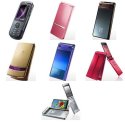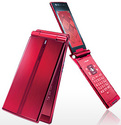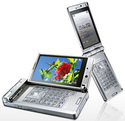LiMo touts new phones, members
Aug 4, 2008 — by Eric Brown — from the LinuxDevices Archive — 5 views The LiMo (Linux Mobile) Foundation has announced seven new shipping mobile handsets — from Motorola, NEC, and Panasonic — that are said to comply with its mobile phone specification. The consortium also announced 11 new members, including Telecom Italia, Freescale, VirtualLogix, Movial, and PacketVideo.
The LiMo (Linux Mobile) Foundation has announced seven new shipping mobile handsets — from Motorola, NEC, and Panasonic — that are said to comply with its mobile phone specification. The consortium also announced 11 new members, including Telecom Italia, Freescale, VirtualLogix, Movial, and PacketVideo.
The seven new models from Motorola, NEC, and Panasonic brings the total number of shipping LiMo-compliant handsets to 21. Although the three companies have already been shipping other LiMo-compliant models, the new announcements continue to add to the momentum LiMo has been building since February, when it announced the first wave of LiMo handsets, along with 18 new members. The momentum continued in March when the consortium announced the first release of the LiMo Platform specification, and reached new heights in May when Verizon Wireless joined along with seven new members.
Meanwhile, LiMo's chief Linux-based rival, the Android specification from Google and the Open Handset Alliance, has suffered a bit of a setback with the news that Android-compliant phones will now ship in the fourth quarter, instead of the third as previously hoped. The other new open-source player on the scene, Nokia's upcoming open source version of the Symbian OS, won't be ready to roll for a year or two, so now LiMo has an opportunity to make inroads against its more well-known rivals.
Seven new models
The seven new LiMo-compliant phones include four from NEC, two from Panasonic, and one from Motorola. Underscoring the maturity of its platform, LiMo boasts that NEC now offers eight LiMo-compliant models in all, while NEC offers seven, and Motorola five.




Four new LiMo-compliant NEC phones:
NEC N706i, NEC N906il, NEC N906iu (micro), NEC N906i
(Click any to enlarge)


Two new Panasonic phones:
Panasonic P706iu, Panasonic P906i
(Click either to enlarge)

Motorola's new MotoZINE ZN5
(Click for details)
The MotoZine ZN5 is Motorola's second “Mode-shifting” phone, featuring a “soft-MMU” (man-machine interface) touchpanel with haptic feedback. The panel changes form and function according to its three modes, which include telephony, photo-/video-graphy, and media player. Motorola has offered Linux phones for more than five years, and continues to use MontaVista kernels and an embedded graphics framework from Trolltech.
The new NEC and Panasonic phones represent those companies' sixth-generation of phones based on Linux, and offered through NTT DoCoMo, Japan's largest network. Along with 3G data networking, the phones offer the usual range of on-demand media streaming, videoconferencing, and electronic wallet features long available to mobile phone customers in Japan, which enjoys one of the most advanced mobile phone networks in the world.
A month ago, LiMo executive director Morgan Gillis told a Forbes reporter that he expected ten new LiMo phones by the end of July. However, one of the expected new models, Samsung's SGH-i800, may have been cancelled, according to a rumor story at computer industry gossip site TheInquirer.
LiMo membership multiplies
The newly announced LiMo members, meanwhile, were hinted at in late June when the Linux Phone Standards (LiPS) Forum announced that it was closing up shop and folding its standards-development activities and membership into the LiMo Foundation in July. By that time, many of the LiPS members had already joined LiMo.
Not all of new round of LiPS refugees made the jump to LiMo, however, including Spreadtrum, and most notably, British Telecom. The addition of Telecom Italia, however, adds to LiMo's growing list of major mobile carriers. Carriers ultimately make the determination of which handsets to promote to their customer base, so having lots of carriers among LiMo's ranks bodes well for Linux phones.
The list of new members bring LiMo's membership tally to 52. They are:
- Cellon — a large handset manufacturer based in China
- Esmertec — a Java virtual machine provider
- Freescale — a semiconductor vendor
- Longcheer Holdings — a large handset manufacturer based in China
- MIZI Research — an embedded Linux graphics framework provider based in Korea
- Movial — an embedded Linux UI stack and integration services house based in Linux's ancestral homeland (Finland)
- PacketVideo Corporation — a vendor of embedded multimedia software
- SK Innoace — apparently a stealth-mode startup
- Telecom Italia — an important global carrier
- VirtualLogix Inc. — a virtualization stack vendor most established in carrier infrastructure
- ZTE Corporation — a large handset manufacturer based in China
Mini-Interview with LiMo
All seven of the new LiMo phones are based on extremely mature Linux stacks. NEC and Panasonic began building their jointly maintained “MOAP/L” Linux stack in 2003, after NTT DoCoMo announced plans to adopt Linux for its 3G phones. Motorola, meanwhile, announced plans to “go Linux” more than five years ago. All three vendors subsequently used Linux in multiple generations of Linux phones.
Yet, according to Andrew Shikiar, director global marketing for the LiMo Foundation, new platforms on the way. These will include reference stacks from Access, Purple Labs, and Azingo, all of which are LiMo members. And while the LiMo phones announced today are all based on MontaVista kernels, Wind River and others will also see their mobile phone distributions of Linux used in LiMo phones, Shikiar said.
Shikiar also said that new LiMo members will bring considerable assets to the organization. Telecom Italia has long been a thought leader in mobile Linux,” he noted.
On the software front, Shikiar was excited by the potential contributions from PacketVideo and Movial. Today Movial announced open-source, Limo-ready code called the Browser D-Bus Bridge that enables a direct connection between UI widgets and D-Bus activity, thereby streamlining the development of complex mashup apps that can leverage all of a phone's resources. “They are both representative of the general direction and growth of our membership,” he said. “Our base used to be OEMS and operators, but we've kind of grown outwards to include integrators and middleware vendors, as well as software and solution providers who are higher up the stack, and who want to provide functionality to the spec. These are companies that are going to contribute to the code.”
Looking forward, Shikiar says that the consortium is still planning to release the Release 2 platform and the new LiMo SDKs by the end of the year. R2-based devices, meanwhile, would appear “in 2009.”
Asked about Nokia's decision to open source Symbian, Shikiar said the move was neither a surprise, nor a major threat. “It means we're moving toward a more collaborative environment,” he said. “We see it as an endorsement of the strategy we developed. LiMo has had an advanced and intricate governance model, and now analysts have said the governance model they're working on for Symbian will be very similar, so we see it is a validating point for the idea of collaboration and openness. It allows us to shift the conversation around openness from debating its merits to talking about tactics.”
As for Android, it's “good for mobile Linux,” said Shikiar. “These are huge names, Nokia and Google, industry giants with wonderful products, and they are now working on a model of collaboration,” he continued. “Still, we think LiMo is uniquely positioned with our governance, licensing, and our appeal to leaders in the mobile industry.”
When asked whether LiMo was concerned with its lack of name recognition among the public and the press, where it's often left out of mobile industry discussions about Google, Nokia, Apple, and RIM, Shikiar said that at least as far as the buying public went, that was the way LiMo preferred it. “Part of the appeal of LiMo is that we're not out there with grand ambitions to do consumer marketing and branding,” he said. “That is appealing to the operators. You're not going to have kids clamoring for the latest LiMo phone, but they will be looking for that cool Motorola or Samsung device.”
Shikiar also noted that its members, and especially the operators, appreciate the fact that “no one company has a disproportionate influence over the platform.” He went on to note that “that's going to be a challenge for Symbian.”
This article was originally published on LinuxDevices.com and has been donated to the open source community by QuinStreet Inc. Please visit LinuxToday.com for up-to-date news and articles about Linux and open source.